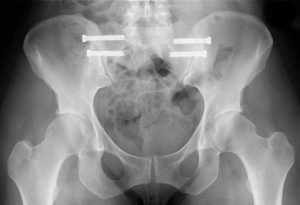SI Joint Pain & Sacroiliac Joint Injection
 WHAT ARE SI JOINTS?
WHAT ARE SI JOINTS?
The sacroiliac joints are the large joints of the low back where the pelvis joins the spine. The main function of these joints is to absorb excess of shock in the legs, pelvis and between the upper body. Typically, the sacroiliac joints don’t have a lot of motion. The little motion they have helps in shock absorption and bending forward and backwards.
The joint is surrounded by a strong network of ligaments, some of which reinforce the back of the pelvis. These strong ligaments limit the joint movement, provide enough support and help in absorbing shock and pressure.
WHAT IS SACROILIAC JOINT DYSFUNCTION?
Sacroiliac joint dysfunction is an injury or inflammation of the joint, which may cause pain in the lower back, buttocks and some times groin and legs. Patients often relate a history of trauma such as a fall on the buttocks or a motor vehicle accident. Pain may also begin after simple twisting motions that combine bending forward, tilting the pelvis, or twisting the trunk as in a golf swing, shoveling snow, or bending and reaching sideways to pick an object off the floor.
Sacroiliac joint dysfunction can cause spine chilling pain in the lower back and legs. Leg pain that you experience from sacroiliac joint dysfunction is very similar to the pain caused by sciatica or lumbar disc herniation. Simply put, sacroiliac pain refers to the pain caused by the sacroiliac joint when they either move too much or too little.
Today, it is found that about 15 to 30 per cent of lower back pain cases are caused by sacroiliac joint dysfunction.
WHAT ARE THE CAUSES OF SI JOINT PAIN?
Sacroiliac joint dysfunction or sacroiliitis is mainly caused by the inflammation of either one or both sacroiliac joints. Sacroiliitis can also be caused due to SI joint dysfunction which is a more generalized term for the following conditions:
 OSTEOARTHRITIS
OSTEOARTHRITIS
Over the years, excessive pressure on the SI joints can result in wearing of cartilage which is the reason behind osteoarthritis.
Osteoarthritis is linked with aging and also impacts the spine and other joints of your body.
ANKYLOSING SPONDYLITIS
Ankylosing spondylitis is a kind of inflammatory arthritis that impacts the joints connected to the spine and vertebrae column. Not only does AS cause immense pain, but it also leads to new bone growth that pressures the joints into the spine. While the primary attack-area of AS is the sacroiliac joint, it can also cause inflammation in other parts of the body including the joints as well as the organs.
Ankylosing spondylitis is a serious situation which should be diagnosed and treated when it’s still in its early phase. If left untreated for long, it can cause major movement difficulties. The disease is most common in young men.
TRAUMATIC IMPACT INJURY
Sudden falls, jerks, or car accidents can cause major injuries in the sacroiliac joints.
PREGNANCY
Relaxin, a hormone which is secreted during pregnancy, makes the sacroiliac joints elastic. This widens up the pelvis to help the delivery. It is an important phenomenon to occur, but it impacts the joints and makes them less stable. When these conditions are combined with weight gain, this can lead to SI joint dysfunction. Women who are subjected to such conditions are at great risk of getting SI joint arthritis.
ABNORMAL WALKING PATTERNS
Irregular walking patterns can lead to SI joint dysfunction. Abnormal walking patterns can be caused due to irregular legs (having one leg shorter than the other). If you correct these issues, SI joint pain may be minimized.
Weight gain can also make you walk abnormally, for example, during pregnancy. In such conditions, sacrum pain will go away as you shed your weight and assume a typical walking pattern.
SI JOINT PAINT SYMPTOMS
SI joint pain occurs in different ways to different people. The most common symptoms include:
- Severe pain in lower back
- Severe pain in hips, buttocks and pelvis
- Severe pain in the groin
- Weakness
- Numbness
- Severe pain while standing and sitting
- Burning sensation in pelvis
- Cramps in upper legs and thighs
- Difficulty in walking and bending
TREATMENTS FOR SACROILIAC JOINT PAIN
PHYSICAL THERAPY, EXERCISE AND SELF CARE
Physical therapy sessions, low-impact exercises such as stretching and yoga and gentle massage can help in minimizing pain and strengthening the SI joints.
Another useful remedy is to use a cold compress to ease the pain. If the pain is manageable, you can also use heat pads or heat belts or can also try warm water soak for pain relief.
To support the SI joint, you can also try wearing a sacroiliac belt which will help you in moving with less pain.
 NON-SURGICAL SI JOINT PAIN MEDICATION AND REHABILITATION
NON-SURGICAL SI JOINT PAIN MEDICATION AND REHABILITATION
If physical therapy, exercise and home remedies aren’t helpful or you’re experiencing unbearable pain or suffering from AS, you should visit your doctor and try out the non-surgical therapies and medication.
Some useful SI joint pain medications include:
- Anti-inflammatory medications such as ibuprofen, aspirin and naproxen
- Oral steroids for a limited time
- Muscle relaxants
- Radiofrequency ablation for deactivating the nerves
- Corticosteroid injections
SACROILIAC JOINT INJECTION FOR LOWER BACK PAIN
The sacroiliac steroid injection procedure is typically performed in an operating room. The patient lies on her/his stomach. The skin over the joint is cleaned with antiseptic solution and is injected with local anesthetic, after which the sacroiliac joint injection is performed under X-ray guidance. The medication is commonly a combination of local anesthetic, steroid and x-ray dye. The entire procure is quick and only takes minutes with the patient going home the same day. The patient should have significant pain relief following the injection.
SACROILIAC JOINT INJECTION PAIN
Some patients get pain relief immediately after the injection, while others take 2-3 days for the steroid to take effect. The pain may worsen for the day or two until the medication starts kicking in. There also may be soreness at the injection site for a few days after the procedure, and you should avoid any intense activities during the same time period.
SI JOINT INJECTION SIDE EFFECTS

There are few risks, complications, or side effects of sacroiliac joint injections, but there are a few. There is a small risk with any medication that a possible allergic reaction could happen. There may also be bruising and soreness at the injection site. Also with any procedure that is a small risk of infection at the injection site, though these are minimized by proper sterilization before the procedure.
SI JOINT SURGERY
Surgery is the last option. If you can’t manage your pain with non-surgical therapies and medications, your doctor may suggest surgery. The sacroiliac joint surgery stabilizes the joint using small plates and screws. This operation is called sacroiliac joint fusion, and grafts together the ilium and sacrum. Minimally invasive procedures are available for this kind of surgery.
SI JOINT PAIN EXERCISES

You can make pain caused by SI joint dysfunction less progressive by making healthy lifestyle choices and staying fit and active. There are a few exercises you can try to alleviate your pain. Hip abduction strengthening is one of the best exercises to help with SI joint pain. The hip abductor muscles on the outside of the thighs and inside of the thighs will help support the pelvis and sacroiliac joint. To perform hip abductor exercises you should be laying on your back with knees slightly bent and a resistance band around your knees. With the back arched push the knees apart to strengthen the outer thighs, and hold for 5 seconds repeated 10 times.
To perform inner hip abductor strengthening you’ll assume the same position, but have an exercise ball between your knees and squeeze the ball together for 5 seconds, repeated 10 times. The bridge exercise strengthens the lower abdomen, lower back and hips. In this exercise you’ll lie on the back with the knees bent and palms flat on the floor, then lift hips in the air for 5 seconds, repeated 10 times.
SACROILIAC JOINT PAIN REMEDY OUTLOOK
Sacroiliac pain can be both short-term and long term. When it is caused during pregnancy and due to weight gain, accident or physical injury, it will go away as your body recovers. However, if it is caused by chronic conditions such as osteoarthritis and AS, you may need to rely on medication for pain management. Injections can greatly reduce the pain you experience, and surgery can permanently solve SI joint pain. Exercising is a good supplement to most procedures during the recovery process, or as a first step in trying to alleviate pain. You’ll have to discuss with your doctor which type of approach works for you when treating SI joint pain, as each patient is unique.


